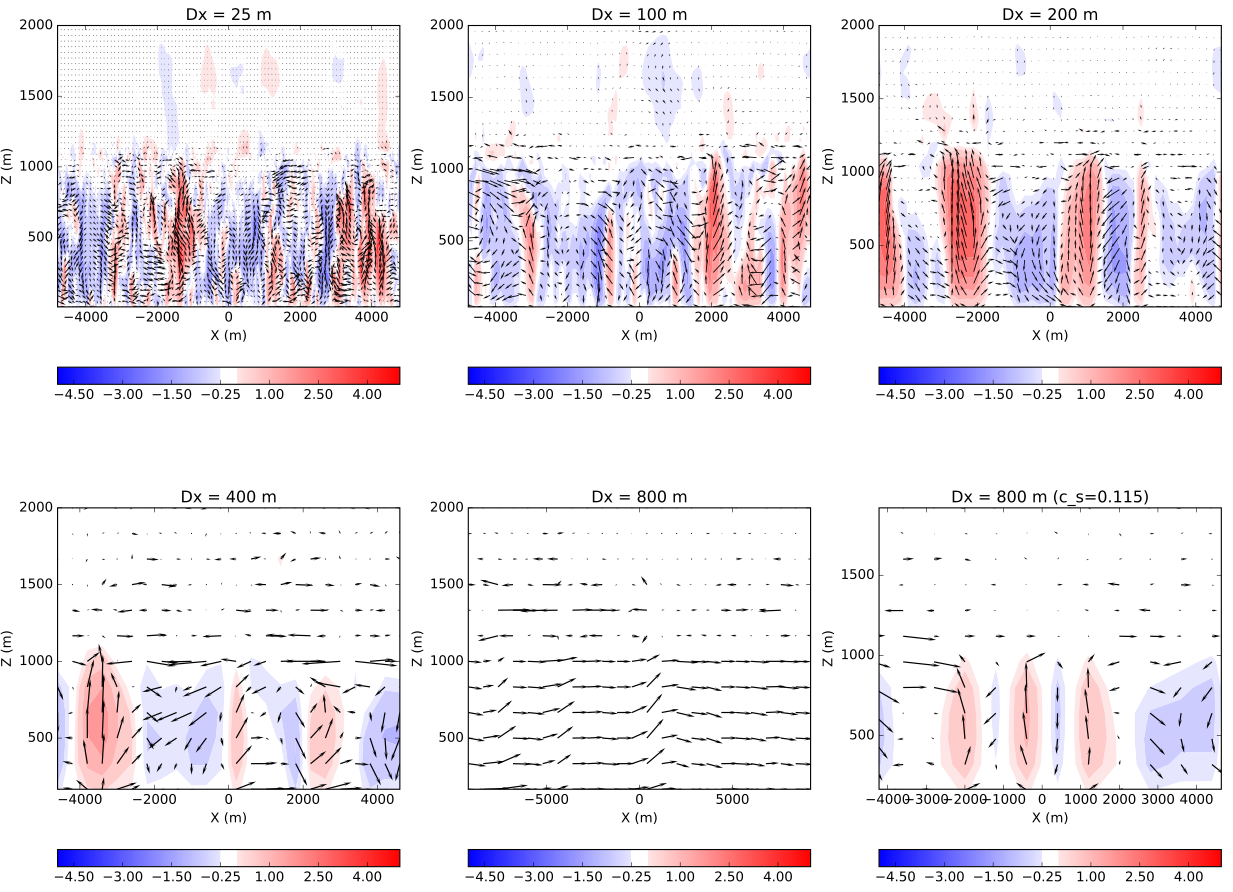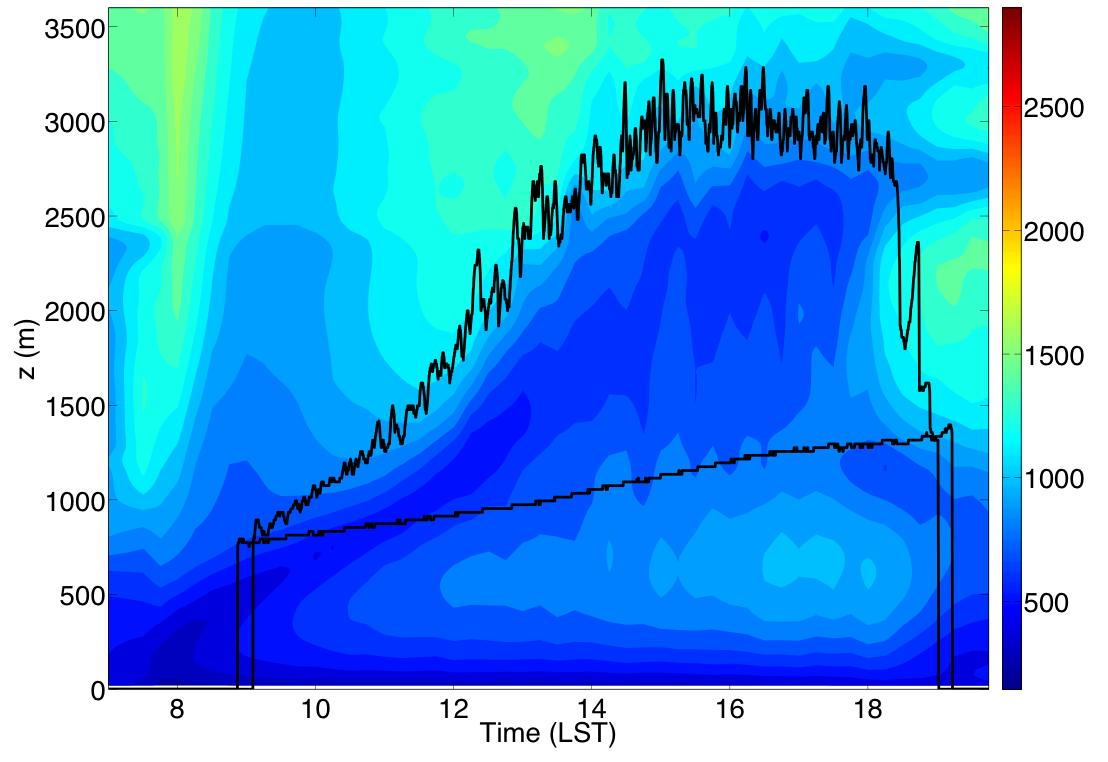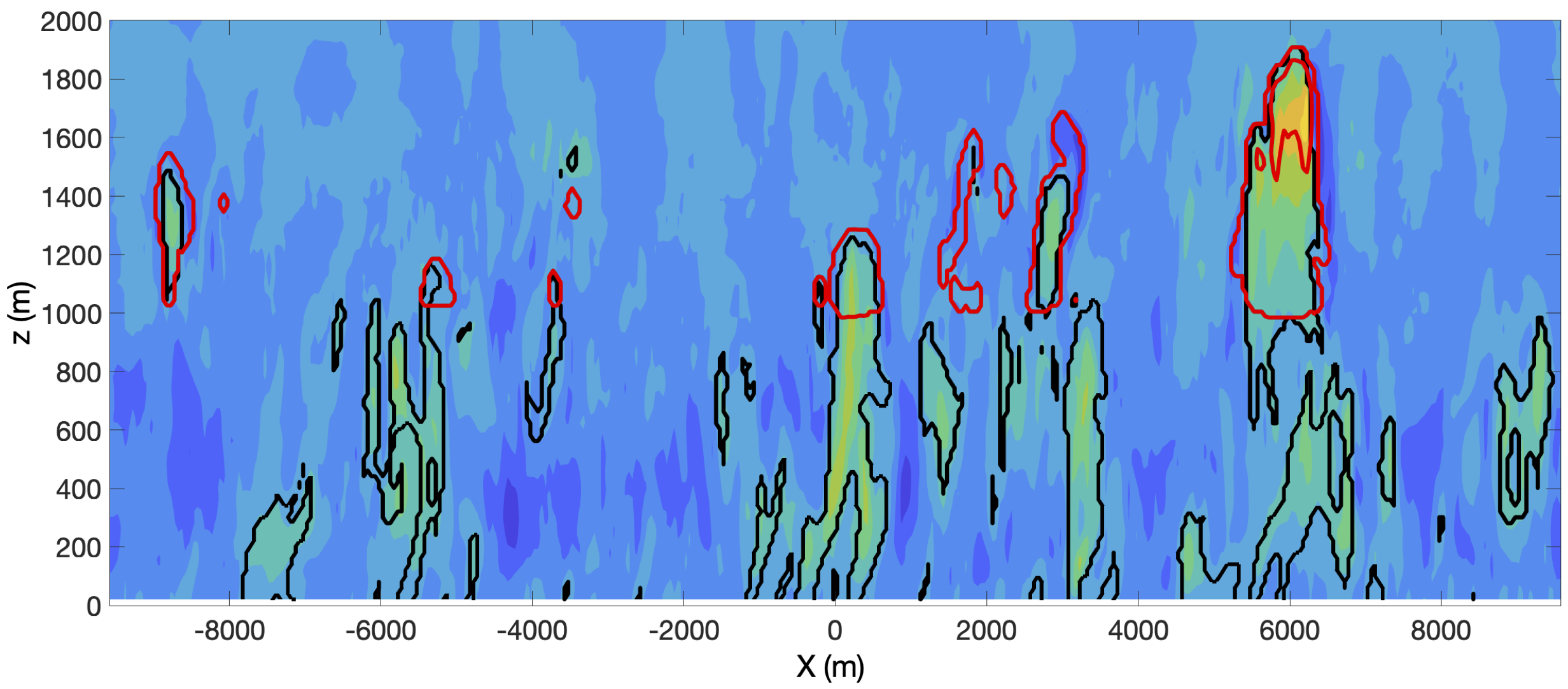Overview
About me:
I hold a NERC Independent Research Fellowship aiming to provide a step-change in our ability to predict high-impact weather events by developing a novel turbulence parametrization for the next generation, sub-kilometric atmospheric models. More specifically, I am working on pusing the spatial resolution of Numerical Weather Prediction (NWP) models to finer grid spacings in order to significantly improve the forecast of deep convection which is associated with the most violent meteorological phenomena on earth. My research focuses on understanding the dynamics of convection accross the scales and the coupling of the atmospheric boundary layer with shallow and deep moist convection. To achieve this, I am using numerical modelling to simulate the turbulent motions in the boundary layer and convective clouds, aiming to develop appropriate parametrizations for the unresolved scales in high-resolution NWP models.
I joined the University of Exeter as a post-doctoral researcher in November 2013. I was part of the GREYBLS (Modelling GREY - zone Boundary LayerS) project with Prof Bob Beare, in collaboration with the Department of Meteorology, University of Reading and the UK Met Office. The goal of the project was to study the behaivour of boundary-layer convection at grey-zone resolutions and the interaction between the partially-resolved and sub-grid turbulence structures.
Then I moved on working as a Research Fellow on the Met Office/NERC funded ParaCon/CoDyPhy project (https://www.metoffice.gov.uk/research/collaboration/paracon) led by Prof Thuburn, which aims at a unified representation of convection across the scales, based on a novel multi-fluid framework.
I am a Fellow of the Royal Meteorological Society and a member of the scientific committee that is launching the second phase of the Grey Zone Project (more information here).
I hold a Ph.D in Atmospheric Sciences/Meteorology from University of Ioannina, Greece and a M.Sc. in Atmospheric Physics from the Aristotle University of Thessaloniki, Greece.
Current research interests:
- Ultra-fine-resolution Numerical Weather Prediction
- Large-Eddy Simulation (LES) of atmospheric flows
- Turbulence modelling
- Boundary layer and mesoscale meteorology
- Deep convection
- Synoptic meteorology
- Dynamics of heavy rainfall events and high-impact weather
- Interaction of turbulent transport with the synoptic environment
Grants:
NERC Independent Research Fellowship (P.I.): “Adaptive turbulence modelling to improve high-impact weather forecasts in next generation atmospheric models”
Full publication list:
https://orcid.org/0000-0003-3469-8729
Publications
Copyright Notice: Any articles made available for download are for personal use only. Any other use requires prior permission of the author and the copyright holder.
| 2021 | 2020 | 2019 | 2018 | 2016 | 2015 | 2014 | 2013 | 2012 | 2011 | 2010 | 2008 | 2006 |
2021
- Bopape MJM, Plant RS, Coceal O, Efstathiou GA, Valdivieso M. (2021) Effects of stability functions in a dynamic model convective boundary layer simulation, Atmospheric Science Letters, volume 22, no. 1, DOI:10.1002/asl.1008.
2020
- Honnert R, Efstathiou GA, Beare RJ, Ito J, Lock A, Neggers R, Plant RS, Shin HH, Tomassini L, Zhou B. (2020) The Atmospheric Boundary Layer and the “Gray Zone” of Turbulence: A Critical Review, Journal of Geophysical Research: Atmospheres, volume 125, no. 13, DOI:10.1029/2019jd030317. [PDF]
2019
- Fragkos K, Antonescu B, Giles MD, Ene D, Boldeanu M, Efstathiou AG, Belegante L, Nicolae D. (2019) Assessment of the total precipitable water from a sun photometer, microwave radiometer and radiosondes at a continental site in southeastern Europe, Atmospheric Measurement Techniques, volume 12, no. 3, pages 1979-1997, DOI:10.5194/amt-12-1979-2019.
- Kealy JC, Efstathiou GA, Beare RJ. (2019) The Onset of Resolved Boundary-Layer Turbulence at Grey-Zone Resolutions, Boundary-Layer Meteorology, volume 171, no. 1, pages 31-52, DOI:10.1007/s10546-018-0420-0.
2018
- Fragkos K, Antonescu B, Ene D, Efstathiou GA, Belegante L. (2018) Assessment of the total precipitable water from a sun-photometer, microwave radiometer and radiosondes at a continental site in southeastern Europe, pages 1-30, DOI:10.5194/amt-2018-237.
- Efstathiou G, Plant RS. (2018) A dynamic extension of the pragmatic blending scheme for scale‐dependent sub‐grid mixing, Quarterly Journal of the Royal Meteorological Society, DOI:10.1002/qj.3445.
- Efstathiou G, Plant R, Bopape M-J. (2018) Simulation of an evolving convective boundary layer using a scale-dependent dynamic Smagorinsky model at near-grey-zone resolutions, Journal of Applied Meteorology and Climatology, volume 57, pages 2197-2214, DOI:10.1175/JAMC-D-17-0318.1.
2016
- Efstathiou GA, Beare RJ, Osborne S, Lock AP. (2016) Grey zone simulations of the morning convective boundary layer development, Journal of Geophysical Research: Atmospheres, volume 121, no. 9, pages 4769-4782, DOI:10.1002/2016jd024860. [PDF]
2015
- Efstathiou GA, Beare RJ. (2015) Quantifying and improving sub-grid diffusion in the boundary-layer grey zone, Quarterly Journal of the Royal Meteorological Society, volume 141, no. 693, pages 3006-3017, DOI:10.1002/qj.2585.
- Efstathiou GA, Beare RJ. (2015) Quantifying and improving sub‐grid diffusion in the boundary‐layer grey zone, Quarterly Journal of the Royal Meteorological Society, volume 141, no. 693, pages 3006-3017, DOI:10.1002/qj.2585. [PDF]
2014
- Efstathiou GA, Lolis CJ, Zoumakis NM, Kassomenos P, Melas D. (2014) Characteristics of the atmospheric circulation associated with cold-season heavy rainfall and flooding over a complex terrain region in Greece, Theoretical and Applied Climatology, volume 115, no. 1-2, pages 259-279, DOI:10.1007/s00704-013-0899-8.
2013
- Efstathiou GA, Lolis CJ, Zoumakis NM, Kassomenos P, Melas D. (2013) Characteristics of the atmospheric circulation associated with cold-season heavy rainfall and flooding over a complex terrain region in Greece, Theoretical and Applied Climatology, pages 1-21.
- Efstathiou GA, Zoumakis NM, Melas D, Lolis CJ, Kassomenos P. (2013) Sensitivity of WRF to boundary layer parameterizations in simulating a heavy rainfall event using different microphysical schemes. Effect on large-scale processes, Atmospheric Research, volume 132-133, pages 125-143, DOI:10.1016/j.atmosres.2013.05.004.
2012
- Efstathiou G, Melas D, Zoumakis N, Kassomenos PA. (2012) Evaluation of WRF-ARW Model in Reproducing a Heavy Rainfall Event Over Chalkidiki, Greece: The Effect of Land-Surface Features on Rainfall, Advances in Meteorology, Climatology and Atmospheric Physics, Springer Nature, 65-71, DOI:10.1007/978-3-642-29172-2_10.
- Efstathiou GA, Zoumakis NM, Melas D, Kassomenos P. (2012) Impact of precipitating ice on the simulation of a heavy rainfall event with advanced research WRF using two bulk microphysical schemes, Asia-Pacific Journal of Atmospheric Sciences, volume 48, no. 4, pages 357-368, DOI:10.1007/s13143-012-0034-2.
2011
- Zoumakis M, Petrakakis M, Kassomenos P, Kelessis A, Bournis N, Zoumakis N, Papadakis N, Vosniakos F, Staliopoulou M, Efstathiou G. (2011) Human discomfort due to environmental conditions in urban Thessaloniki, Greece. Part I. Air quality stress levels, Journal of Environmental Protection and Ecology, volume 12, no. 2, pages 407-415.
- Zoumakis M, Kassomenos P, Zoumakis N, Efstathiou G, Papadakis N, Vosniakos F, Kelessis A, Petrakakis M, Bournis N, Staliopoulou M. (2011) Human discomfort due to environmental conditions in urban Thessaloniki, Greece. Part III. Combined effect of temperature and humidity, Journal of Environmental Protection and Ecology, volume 12, no. 2, pages 463-470.
- Zoumakis M, Kassomenos P, Petrakakis M, Zoumakis N, Bournis N, Kelessis A, Papadakis N, Vosniakos F, Staliopoulou M, Efstathiou G. (2011) Human discomfort due to environmental conditions in urban Thessaloniki, Greece. Part II. Thermal stress levels, Journal of Environmental Protection and Ecology, volume 12, no. 2, pages 457-462.
- Zoumakis M, Kassomenos P, Zoumakis N, Papadakis N, Vosniakos F, Staliopoulou M, Efstathiou G, Kelessis A, Nikolaou K, Bournis N. (2011) Human discomfort due to environmental conditions in Urban Thessaloniki, Greece. Part IV. Heat-related mortality (Preliminary results), Journal of Environmental Protection and Ecology, volume 12, no. 3, pages 911-920.
- Zoumakis M, Kassomenos P, Zoumakis N, Papadakis N, Vosniakos F, Staliopoulou M, Efstathiou G, Kelessis A, Papapreponis P, Bournis N. (2011) Human discomfort due to environmental conditions in Urban Thessaloniki, Greece. Part V. Adaptation to the local climate (Preliminary results), Journal of Environmental Protection and Ecology, volume 12, no. 3, pages 921-929.
2010
- Papas D, Efstathiou GA, Zoumakis NM, Koutroubelis S, Kelessis AG, Petrakakis MJ. (2010) MODELLING OF TRAFFIC POLLUTION AT AN URBAN SITE USING A MICROSCALE CFD DISPERSION MODEL, FRESENIUS ENVIRONMENTAL BULLETIN, volume 19, no. 9B, pages 1997-2001. [PDF]
- Papas D, Efstathiou GA, Zoumakis NM, Koutroubelis S, Kelessis AG, Petrakakis MJ. (2010) Modelling of traffic pollution at an urban site using a microscale CFD dispersion model, Fresenius Environmental Bulletin, volume 19, no. 9 B, pages 1997-2001.
2008
- Zoumakis NM, Efstathiou GA, Kelessis AG, Petrakakis MJ, Kouvas DG, Papas DG. (2008) APPROXIMATE SOLUTIONS OF THE RADIATION BUDGET EQUATION IN COMPLEX TERRAIN, FRESENIUS ENVIRONMENTAL BULLETIN, volume 17, no. 10A, pages 1577-1583. [PDF]
- Zoumakis NM, Efstathiou GA, Kelessis AG, Petrakakis MJ, Kouvas DG, Papas DG. (2008) Approximate solutions of the radiation budget equation in complex terrain, Fresenius Environmental Bulletin, volume 17, no. 10 A, pages 1577-1583.
2006
- Zoumakis NM, Efstathiou GA. (2006) Parameterization of inversion breakup in idealized valleys. Part I: The adjustable model parameters, Journal of Applied Meteorology and Climatology, volume 45, no. 4, pages 600-608, DOI:10.1175/JAM2353.1.
- Zoumakis NM, Efstathiou GA. (2006) Parameterization of inversion breakup in idealized valleys. Part II: Thermodynamic model, Journal of Applied Meteorology and Climatology, volume 45, no. 4, pages 609-623, DOI:10.1175/JAM2354.1.
- Zoumakis NM, Efstathiou GA, Kelessis AG, Triandafyllis J, Papas D, Chasapis M, Petrakakis M, Karavelis P. (2006) A simple scheme for daytime estimates of surface energy budget in complex terrain, Fresenius Environmental Bulletin, volume 15, no. 8 B, pages 923-927.
Further information
Research
Modelling the Boundary-Layer Grey Zone:
The recent significant increase of computer power means that NWP models are now able to operate at sub-kilometre horizontal resolutions. For the convective boundary layer this leads to partially-resolved convective structures (thermals). At these resolutions the dominant turbulence length scales become comparable to the grid spacing and directly affected by the effective dissipation. The lack of a clear seperation of scales means that neither RANS nor LES approaches are appropriate for the modelling of sub-grid turbulent transfer. Therefore, NWP is now entering the "Terra Incognita" or the boundary layer "grey zone", where little is known about how the boundary layer and turbulent motions in general, should be represented in high-resolution atmospheric models.

Panel plot on the left: Vertical cross sections of vertical velocity taken from numerical simulations of a CBL at different horizontal resolutions, starting from the the LES limit (Δx = 25m). Bottom-right and bottom-middle figures show the impact of a reduced sub-grid mixing length at resolved motions in the grey zone (Δx = 800m).
I gave an invited talk on dynamic sub-grid modelling of the evolving convective boundary layer, at the ECMWF "Shedding light on the greyzone workshop" on November 2017. (See a video recording of the talk.)
Dynamic sub-grid modelling of moist convection
Turbulence length-scales can be affected by the physical characterisitics of the flow. Different flow regimes exist where the dominant length scales might differ, such as the evolving boundary layer and the cloud layer, Therefore, sub-grid mixing length scales should adapt to the flow field and the resolved turbulence structures. Dynamic modelling determines the sub-grid mixing lengths by using the resolved scales, which makes dynamic approaches suitable for regions where there is no clear scale seperation.

Plot above: Dominant length scales (filled contours in m) of vertical velocity spectra during the ARM shallow cumulus case study, as simulated by the Met Office LEM. Black lines denote BL and cloud layer extent.
Identifying coherent structures in the Boundary Layer - Shallow Cu
How can we partition BL flow into coherent (thermals/non-local) and small-scale (local) motions? The continuous flow of energy from the turbulence energy-production to the dissipation scales makes this distinction difficult. Many parametrization approaches require this information beforehand. I am working towards a method to partition the flow based on optimizing the turbulent vertical scalar flux in a two-fluid representation of the BL.

Plot above: Vertical cross-section of vertical velocities from a Large-Eddy Simulation of the ARM shallow cumulus case study with the Met Office LEM. Bold black lines identify the extend of coherent structures according to the new optimization methodology. Red lines represent the edges of cloud structures.
See a paper published in Boundary-Layer Meteorology and a presentation I gave at the Convection Parametrization: Progress and Challenges workshop, held at the UK Met Office on July 2019.



